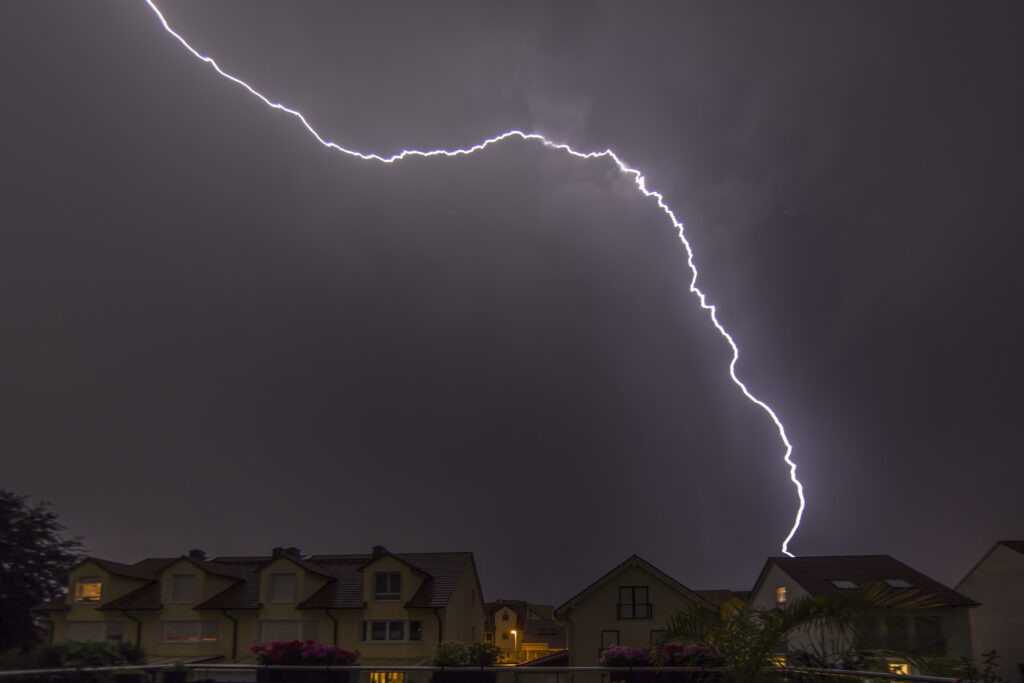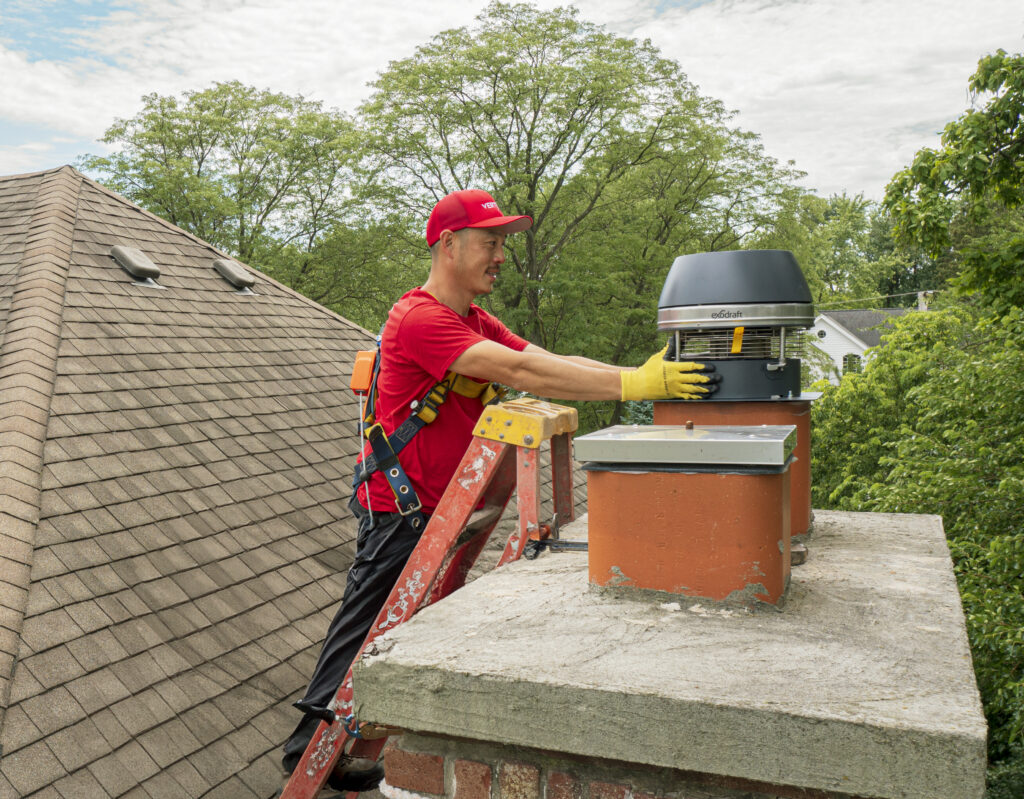
Lightning damage to chimneys is a significant concern, potentially leading to chimney fires and structural damage, as well as making chimneys the highest points on homes and thus more susceptible to lightning strikes. Knowing if a chimney struck by lightning can save your home from potential dangers.
With lightning strikes causing approximately 22,600 fires and $451 million in property damage annually, understanding the signs of damage and the steps for chimney repair or chimney masonry repair becomes paramount, especially since most of these strikes occur during the thunderstorm season in summer. This article aims to help you swiftly assess storm damage, explore professional inspection and repair options, and consider preventive measures to protect your chimney against future lightning strikes.
Immediate Actions to Take Post-Strike
After your chimney has been struck by lightning, taking immediate and proper actions is critical to ensuring the safety and integrity of your home. Here's a concise guide on the steps to follow:
Initial Safety Checks and Actions:
- Visually inspect your chimney from a safe distance; avoid using the fireplace.
- Check for water leaks and test water pressure by opening taps.
- Stay clear of the chimney, especially exterior walls, to avoid potential hazards from damaged masonry.
Professional Assistance and Reporting:
- Contact a professional roofing company for an in-depth roof inspection.
- Schedule a professional chimney inspection to identify any safety hazards or damage.
- If you suspect a chimney fire, immediately call 911 or your local fire department.
- Report the incident to your insurance company, take photos of the damage, and keep records of all related expenses.
Post-Inspection Steps:
- Follow up with a certified chimney repair company to address any damage found during the inspection.
- Ensure a complete chimney cleaning is done to remove any creosote buildup and debris.
- Implement preventive measures such as using surge protectors, unplugging electronics, and verifying grounding systems to protect your home from future lightning damage.
Taking these steps promptly can help prevent minor issues from escalating into major problems, ensuring the longevity and safety of your chimney and home.
Identifying Signs of Lightning Damage
Identifying signs of damage after your chimney has been struck by lightning is crucial for maintaining the safety and integrity of your home. Here are key indicators to watch for:
Physical Damage to Masonry and Linings:
- Look for masonry debris on the ground beneath the chimney stack, indicating potential damage above.
- Inspect for visible cracks in the chimney crown or liner, and check for large chunks of mortar, brick, or stonework missing.
- Visible warping, buckling, or detachment of metal chimneys or flashing should be addressed immediately.
Signs of Water Intrusion and Chimney Fires:
- Water leaking into your chimney can be a direct consequence of lightning damage, compromising the structural integrity.
- Be alert to the smell of smoke or burning materials, which could indicate a chimney fire ignited by lightning strikes on creosote deposits.
Sounds & Smells:
- Listen for unusual sounds like rumbling, clicking, or tapping, which could suggest a chimney fire.
- A strong smell of smoke when the fireplace is not in use is a red flag that requires immediate attention.
Promptly identifying these signs and seeking professional chimney inspection and repair can prevent further damage and ensure your chimney's safe operation.
How to Assess and Repair the Damage
After identifying signs of lightning damage to your chimney, the next critical step is to assess and repair the damage effectively. Below are structured approaches to ensure a thorough repair process:
Assessment and Repair Process:
Schedule a Professional Chimney Inspection:
- A licensed chimney inspector is crucial to assess hidden damages including masonry, cap, crown, flashing, liner, and other components.
- Even if damage appears minor, an inspection can uncover internal issues not immediately visible.
Identify and Prioritize Repairs:
Critical Components to Repair or Replace:
- Chimney liner, cap, and crown for preventing water intrusion and ensuring structural integrity.
- Bricks and mortar to maintain the chimney's structural safety.
- Chimney flashing to prevent water from entering the home.
- Safety Hazards:
- Damaged liners can allow dangerous gases into living spaces; prioritize their repair.
- Address any dislodged bricks or mortar to prevent chimney collapse.
Selecting a Reputable Contractor:
- Choose contractors with expertise in chimney repair to handle specific damages like masonry repair, liner replacement, or cap installation.
- Verify credentials and references to ensure quality workmanship.
Understanding Repair Costs and Insurance Coverage:
Chimney repair costs can vary widely. Factors include the extent of damage and the components needing repair or replacement. Check your homeowner's insurance policy for coverage on chimney repairs due to lightning strikes to potentially offset costs.
By following these steps, you can ensure that your chimney is repaired efficiently and safely, restoring its integrity and functionality.
Professional Inspection and Repair
After confirming your chimney has been struck by lightning, the next imperative step is seeking professional inspection and repair to ensure the safety and functionality of your chimney. Here's how to proceed:
Selecting the Right Professional:
- Certification: Ensure the chimney inspector and repair company are certified by reputable organizations such as the Chimney Safety Institute of America (CSIA) or the National Fireplace Institute (NFI). This ensures they have the necessary training and adhere to industry standards.
- Experience with Lightning Damage: Choose professionals with specific experience in assessing and repairing lightning strike damage to chimneys. Their expertise is invaluable for identifying hidden damages that could pose future risks.
- Reputation and Reliability: Opt for a contractor known for quality workmanship and reliability. Check reviews and ask for references to gauge their reputation.
Understanding the Inspection and Repair Process:
- Comprehensive Inspection: A certified chimney inspector will conduct a thorough examination, covering all components including the masonry, cap, crown, and liner. This step is crucial for uncovering any internal or structural damages not immediately visible.
- Detailed Repair Plan: Based on the inspection findings, the professional will recommend necessary repairs or replacements. This could range from masonry repair, liner replacement, to cap installation. Prioritize repairs that pose safety hazards, such as damaged liners or dislodged bricks.
Insurance and Cost Considerations:
- Insurance Coverage: Check with your homeowner's insurance to see if chimney repairs due to lightning strikes are covered. This can significantly reduce out-of-pocket expenses.
- Cost Estimates and Warranties: Discuss detailed cost estimates with your contractor. Many reputable chimney repair companies offer warranties for their workmanship and any replaced or installed items, providing additional peace of mind.
By meticulously selecting a qualified professional and understanding the inspection and repair process, you can ensure your chimney is safely and effectively restored, safeguarding your home against potential hazards.
Preventive Measures and Maintenance Tips
To safeguard your chimney and home from future lightning damage and ensure its longevity, consider the following preventive measures and maintenance tips:
Lightning Protection System Installation:
- Install a comprehensive lightning protection system, including a lightning rod and grounding system, to divert lightning strikes away from your chimney and home structure.
- For additional safety, consider a metal roof lightning protection system that works in conjunction with your chimney's lightning rod.
Regular Maintenance and Inspections:
- Schedule annual chimney inspections and cleanings to identify and rectify potential issues such as creosote buildup, animal nesting, or structural weaknesses that could escalate during a storm.
- Post-storm inspections are crucial for detecting and preventing water damage, particularly in the chimney cap, crown, and brick and mortar.
Seasonal Precautions and Professional Services:
- Trim trees and branches near your chimney to prevent them from acting as conductors during lightning storms.
- Utilize waterproofing services to protect your chimney's masonry against water and snow intrusion.
- Plan chimney repairs during spring and summer to benefit from optimal curing conditions and scheduling flexibility.
Conclusion
Understanding the risks of lightning damage to chimneys and taking proactive steps towards inspection and repair are invaluable for the integrity and safety of our homes. By recognizing the signs of lightning impact and engaging with professionals for thorough inspections and repairs, homeowners can prevent further damage and ensure their chimney's operation remains efficient and safe. The journey towards maintaining a secure and functional chimney does not end with repairs; it is an ongoing process that demands awareness, timely action, and partnering with experts who can navigate the complexities of chimney care. To ensure your chimney stands strong against the weather, contact us today! Your home deserves the protection and care that only seasoned professionals can provide, ensuring your safety and comfort through all seasons.
